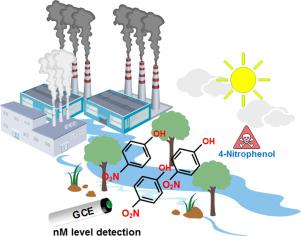当前位置:
X-MOL 学术
›
J. Electroanal. Chem.
›
论文详情
Our official English website, www.x-mol.net, welcomes your
feedback! (Note: you will need to create a separate account there.)
Integrated polyaniline with graphene oxide-iron tungsten nitride nanoflakes as ultrasensitive electrochemical sensor for precise detection of 4-nitrophenol within aquatic media
Journal of Electroanalytical Chemistry ( IF 4.1 ) Pub Date : 2020-09-01 , DOI: 10.1016/j.jelechem.2020.114406 Seyyed Alireza Hashemi , Seyyed Mojtaba Mousavi , Sonia Bahrani , Seeram Ramakrishna
Journal of Electroanalytical Chemistry ( IF 4.1 ) Pub Date : 2020-09-01 , DOI: 10.1016/j.jelechem.2020.114406 Seyyed Alireza Hashemi , Seyyed Mojtaba Mousavi , Sonia Bahrani , Seeram Ramakrishna

|
Abstract Extensive release of highly toxic pollutants within the ecosystem resulting from industrial/human activities has adversely affected the life of living species and raised the requirement for development of sensitive/accurate detection systems for monitoring the level of hazardous pollutants within the ecosystem. Among these toxic pollutants, 4-nitrophenol (4-NP) and its derived compounds applied serious damages to the nature that require practical protocols to remove them from the environment. To address this demand, we boosted the polymeric structure and sensitivity of polyaniline (PANi) through its reinforcement with decorated graphene oxide (GO) nanoflakes with interconnected, porous and highly dense pattern of iron tungsten nitride (GO-ITN) toward modification of glassy carbon electrode (GCE) for precise and real-time detection of 4-NP within the aqueous media. The developed nanocomposite showed superior sensitivity along with improved protonation that exhibited detection limit/quantification limit/sensitivity of 5.2 nM/18.2 nM/253.08 μA.μM.cm −2 and 2.4 nM/7.1 nM/354.92 μA.μM.cm −2 for oxidation and reduction peak currents, respectively. The developed sensor also showed superior sensitivity toward detection of 4-NP within real samples which highlighting the capability and functionality of the developed sensor toward the real-time detection of 4-NP within different aqueous media.
中文翻译:

集成聚苯胺与氧化石墨烯-氮化铁钨纳米片作为超灵敏电化学传感器,用于精确检测水生介质中的 4-硝基苯酚
摘要 工业/人类活动导致生态系统内剧毒污染物的大量释放,对生物物种的生活产生了不利影响,并提出了开发灵敏/准确的检测系统以监测生态系统内有害污染物水平的需求。在这些有毒污染物中,4-硝基苯酚 (4-NP) 及其衍生化合物对自然造成严重破坏,需要采取实际措施才能将其从环境中清除。为了满足这一需求,我们通过使用相互连接的装饰氧化石墨烯 (GO) 纳米薄片增强聚苯胺 (PANi) 的聚合物结构和灵敏度,氮化铁钨 (GO-ITN) 的多孔和高密度图案对玻璃碳电极 (GCE) 的修饰,用于精确和实时检测水介质中的 4-NP。开发的纳米复合材料显示出优异的灵敏度以及改进的质子化,其检测限/定量限/灵敏度分别为 5.2 nM/18.2 nM/253.08 μA.μM.cm -2 和 2.4 nM/7.1 nM/354.92 μA.μM.cm -2氧化和还原峰值电流,分别。开发的传感器还显示出对实际样品中 4-NP 检测的卓越灵敏度,这突出了开发的传感器在不同水介质中实时检测 4-NP 的能力和功能。开发的纳米复合材料显示出优异的灵敏度以及改进的质子化,其检测限/定量限/灵敏度分别为 5.2 nM/18.2 nM/253.08 μA.μM.cm -2 和 2.4 nM/7.1 nM/354.92 μA.μM.cm -2氧化和还原峰值电流,分别。开发的传感器还显示出对实际样品中 4-NP 检测的卓越灵敏度,这突出了开发的传感器在不同水介质中实时检测 4-NP 的能力和功能。开发的纳米复合材料显示出优异的灵敏度以及改进的质子化,其检测限/定量限/灵敏度分别为 5.2 nM/18.2 nM/253.08 μA.μM.cm -2 和 2.4 nM/7.1 nM/354.92 μA.μM.cm -2氧化和还原峰值电流,分别。开发的传感器还显示出对实际样品中 4-NP 检测的卓越灵敏度,这突出了开发的传感器在不同水介质中实时检测 4-NP 的能力和功能。
更新日期:2020-09-01
中文翻译:

集成聚苯胺与氧化石墨烯-氮化铁钨纳米片作为超灵敏电化学传感器,用于精确检测水生介质中的 4-硝基苯酚
摘要 工业/人类活动导致生态系统内剧毒污染物的大量释放,对生物物种的生活产生了不利影响,并提出了开发灵敏/准确的检测系统以监测生态系统内有害污染物水平的需求。在这些有毒污染物中,4-硝基苯酚 (4-NP) 及其衍生化合物对自然造成严重破坏,需要采取实际措施才能将其从环境中清除。为了满足这一需求,我们通过使用相互连接的装饰氧化石墨烯 (GO) 纳米薄片增强聚苯胺 (PANi) 的聚合物结构和灵敏度,氮化铁钨 (GO-ITN) 的多孔和高密度图案对玻璃碳电极 (GCE) 的修饰,用于精确和实时检测水介质中的 4-NP。开发的纳米复合材料显示出优异的灵敏度以及改进的质子化,其检测限/定量限/灵敏度分别为 5.2 nM/18.2 nM/253.08 μA.μM.cm -2 和 2.4 nM/7.1 nM/354.92 μA.μM.cm -2氧化和还原峰值电流,分别。开发的传感器还显示出对实际样品中 4-NP 检测的卓越灵敏度,这突出了开发的传感器在不同水介质中实时检测 4-NP 的能力和功能。开发的纳米复合材料显示出优异的灵敏度以及改进的质子化,其检测限/定量限/灵敏度分别为 5.2 nM/18.2 nM/253.08 μA.μM.cm -2 和 2.4 nM/7.1 nM/354.92 μA.μM.cm -2氧化和还原峰值电流,分别。开发的传感器还显示出对实际样品中 4-NP 检测的卓越灵敏度,这突出了开发的传感器在不同水介质中实时检测 4-NP 的能力和功能。开发的纳米复合材料显示出优异的灵敏度以及改进的质子化,其检测限/定量限/灵敏度分别为 5.2 nM/18.2 nM/253.08 μA.μM.cm -2 和 2.4 nM/7.1 nM/354.92 μA.μM.cm -2氧化和还原峰值电流,分别。开发的传感器还显示出对实际样品中 4-NP 检测的卓越灵敏度,这突出了开发的传感器在不同水介质中实时检测 4-NP 的能力和功能。











































 京公网安备 11010802027423号
京公网安备 11010802027423号